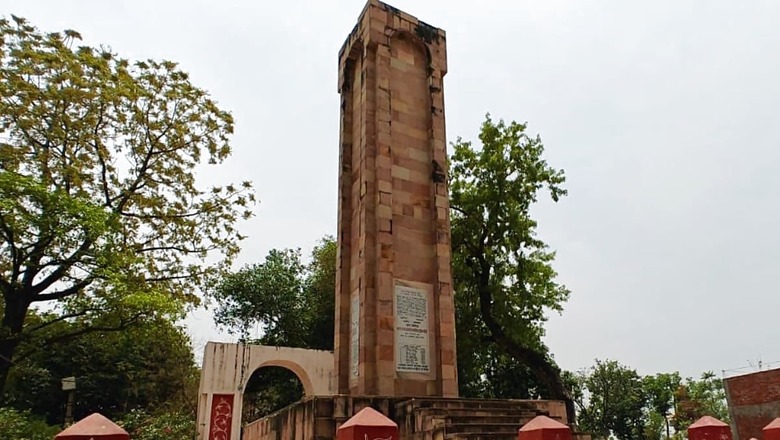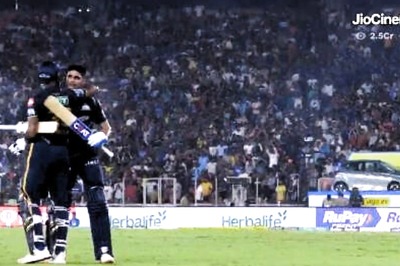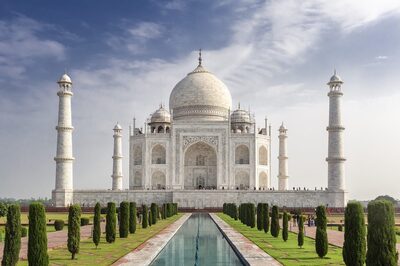
views
Shyam Babu Agrahari, a farmer who hails from Uttar Pradesh’s Raebareli district, was always of the belief that youngsters should be made aware of the selfless contributions of martyrs. To put his words into action, Agrahari bought a 1,500-square-feet piece of land in Raebareli’s historically significant Munshiganj near the main city.
Settled on the banks of River Sai, Munshiganj has been witness to the 1921 Farmers’ Massacre — also known as UP’s Jallianwala Bagh Kand — in which over 700 unarmed farmers were killed by the British Police for protesting against heavy taxation by Zamindars.
Agrahari thought shifting to the urban pocket, which also has a historical connect, would not only give quality life to his two sons but also help inculcate a feeling of patriotism among his children.
Unfortunately, the move turned out to be the farmer’s biggest mistake in life. “I never thought that Munshiganj, despite having such great historical significance, would be left abandoned by the government. I don’t know what are the political reasons behind it but the step-motherly treatment has ruined our life,” said Agrahari.
Not only Munshiganj but several neighbouring villages such as Jagatpur, Korad, Jagrasi, Manheru, Karsa and Dalmau have similar stories to share about their areas in Raebareli which goes to poll on May 20 in the fifth phase of the 2024 Lok Sabha Elections.
Munshiganj, which also houses a ‘Bharat Mata’ Temple and ‘Shaheed Smarak’ — bearing a plaque inscribed with the history of the Munshiganj Massacre — lies in a decrepit state, mainly due to the absence of a bridge to connect it to the main city.
“There is only a small bridge at the Shaheed Smarak, which connects the area to the main city. But this bridge is too narrow and is unfit for two- and four-wheelers. People have to travel 10 kilometres extra to reach the city in absence of any facility,” Suraj Mohanlal, another local from Munshiganj area, said.
Mohanlal blamed poor connectivity issues for the sluggish development of the area. “I am surprised by the apathy as none of the politicians paid any heed towards our long-pending demand for the connecting bridge, which is a basic amenity,” he told News18.
People said some work, which included the construction of the Shaheed Smarak, was done during the regime of the previous government but the issue of the bridge is yet to be addressed. Locals said it was tragic that despite being of great historical importance, the area was subjected to utter neglect.
Recalling the 1921 incident, Sanjiv Bharti, a senior journalist who hails from Raebareli district, said: “Many farmers gathered on January 5 for a public meeting led by Amol Sharma, Baba Jankidas, Baba Ramchandra, Chandrapal Singh, and others. Farmers from nearby villages joined in solidarity. To undermine the meeting, the Talukdar collaborated with the District Magistrate to arrest Sharma and Baba Jankidas and send them to Lucknow jail.”
Bharti said rumours began the next day in Raebareli that the jailed leaders had been murdered, igniting widespread anger among the farmers.
“In protest, on January 7, 1921, a large group of farmers gathered by the sacred Sai River in Munshiganj to demonstrate against the administration. The British government, adopting a repressive stance, deployed numerous police contingents at the site,” said Bharti.
He added that Pandit Jawaharlal Nehru, upon learning of the situation, attempted to reach Raebareli but was stopped by the administration at the railway station, possibly because the British feared his presence could escalate the situation if he were harmed.
“As tensions rose, the administration ordered the police to suppress the protest swiftly, leading to indiscriminate firing on unarmed farmers. The brutal crackdown resulted in approximately 800 farmers being martyred and thousands being injured,” he said.
Bharti said it was widely believed that the river turned red with the blood of the farmers, symbolising the tragic loss. The massacre remains a poignant reminder of the farmers’ struggle and sacrifice in Raebareli’s history.
While celebrating Azadi Ka Amrit Mahotsav to mark the 75 years of India’s Independence, the UP government introduced its mega plans to develop the Shaheed Smarak into a grand tourist spot. There were also talks to build a museum and give a grand look to the Bharat Mata Temple adjacent to the Shaheed Stambh. The plan was chalked out on the orders of UP Chief Minister Yogi Adityanath who made the announcement during his visit to Raebareli on the birth anniversary of the 1857 Revolution hero Rana Beni Madhav.
However, locals said barring some cosmetic changes, nothing much was done. For them, the 2024 Lok Sabha Polls are not just an election but an opportunity to make sure that their demands are noticed. “Though many governments came and went, nothing much was done. But we are hopeful that our long-pending demands will be heard,” another local said.
Residents of the area said Congress leader Priyanka Gandhi visited Shaheed Smarak recently to pay homage to the martyrs. However, no other leaders followed her. “We are hopeful that politicians will visit the place and lend an ear to our problems,” Subhash Singh, another local, said.
Raebareli, which falls under Raebareli Lok Sabha seat, will go to polls on May 20. Congress has fielded Rahul Gandhi from Raebareli and party loyalist KL Sharma from Amethi, keeping Priyanka Gandhi and her husband Robert Vadra out of the electoral contest.
Rahul Gandhi represented Amethi from 2004 until 2019, but he lost the seat to BJP’s Smriti Irani in 2019. He contested from Kerala’s Wayanad in 2019 as a second seat and won it to retain his MP status. He will face Congress defector and three-time MLC Dinesh Pratap Singh of BJP in Raebareli. In the 2019 Lok Sabha elections, Congress leader Sonia Gandhi won the constituency, bagging 5,34,918 votes. Her closest rival, Dinesh Pratap Singh, put up a formidable challenge, gathering 3,67,740 votes.
Raebareli has been a Congress stronghold since the first general elections in 1952 when the seat was held by Feroze Gandhi, the husband of former prime minister Indira Gandhi. After he died in 1960, the Congress fielded RP Singh in the by-elections and retained the seat. Post this, Sonia Gandhi picked Raebareli, a seat she won for four consecutive terms. In February 2024, when Gandhi announced her decision to not contest the next Lok Sabha elections, she wrote a letter to the Raebareli electorate, who supported her for two decades. “My family in Delhi is incomplete; it’s you all in Raebareli who complete it,” wrote the former Congress president. She added that her family’s ties with Raebareli run deep and she received it as a “saubhagya” (good fortune) from her in-laws.
Explore in-depth coverage of Lok Sabha Election 2024 Schedule, Voter Turnout, Upcoming Phase And Much More At News18 Website

















Comments
0 comment